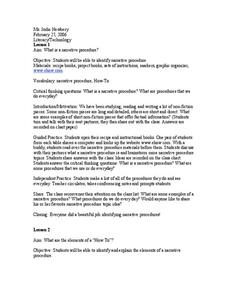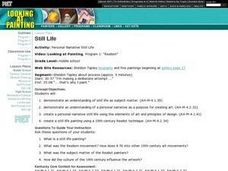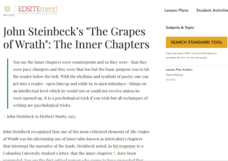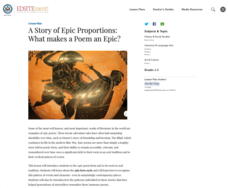Film Foundation
Mr. Smith Goes to Washington: What Is a Movie?
Watching is not the same as seeing. Transform viewers from passive watchers to active students of film with this 34-page packet, filled with lessons and activities that use Mr. Smith Goes to Washington to examine the technology, the...
Curated OER
Epic Poetry: Literary Terms for Story Analysis
What do Star Wars, Indiana Jones, and The Odyssey have in common? Why, they are all epics, of course, and are presented here as examples of the literary term. If you are beginning a study of epics, consider previewing the terms included...
Curated OER
When A Story Met A Sandwich
How is a story like a peanut butter and jelly sandwich? Use making a sandwich as a metaphor to remind your writers that a good, solid beginning, a rich and rewarding middle, and an ending that brings everything together spices up a...
Curated OER
Lesson Plan 2: So What's a Novel, Anyway?
What makes a novel a novel? Class members select a favorite novel, record their impressions on a worksheet, and then come together in groups to discuss the elements common to narrative writing. Next, they identify the characters, the...
Curated OER
Tales of Edgar Allen Poe
Analyze the writing of Edgar Allen Poe by reading and then writing in a similar style. Budding authors learn about the life of Poe and read one or more of his famous works online. Partner groups create an original piece of writing using...
Curated OER
Against the Odds
What factors help people achieve goals? What factors prevent people from achieving goals? What are the elements that need to be in place to make a team function well? Using Damien Lewis’ Desert Claw and John Francome’s Winner Takes All,...
Curated OER
Narrative Procedure
Students identify narrative procedure. In this narrative procedure lesson, students analyze a recipe and visit the website www.ehow.com. Students discuss narrative procedures and answer questions. students make a list of the procedures...
Curated OER
Ordinary People: Unsent Letter
Invite your learners to take on the voice of a character from Ordinary People as they write a letter. Pupils use what they know about the given character to compose their letter, which must relate to the plot of the novel.
Northern Ireland Curriculum
Me Inc.
Build your learners' self-esteem with a series of lessons that focuses on their identity and observation of the world around them. Applicable to many different subjects and lessons, the resources guide kids through the process of...
Curated OER
Still Life - Realism
Students discuss still life painting and the Realism style of art. They plan a personal narrative still life drawing, complete the project and present it to the class.
Curated OER
Splendid China: Chinese Folktales
Students investigate Chinese culture by reading their folk tales. In this creative writing instructional activity, students practice identifying the different elements in a folk tale and examine the related vocabulary. Students...
Curated OER
Creative Writing
Students determine what grammar is and how they have learned it. In this creative writing lesson, students read "Style' Gets New Elements," and respond to the discussion questions. Students then present grammatical rules to one another...
Curated OER
Narrative Strategies
Sixth graders explore strategies authors use to make characters and setting seem real to readers. They develop characters and describe setting in original narratives. Students read myths and determine common themes found in myths from...
Curated OER
Essential Narrative Concepts
Students interact with the main concepts of a narrative text in the six lessons of this unit. The setting, prediction, retelling, sequencing, and the identification of the beggining, middle and end of a story are investigated.
Curated OER
Lesson Plan 8: Setting and Mood
What mood does this story evoke? How are setting and mood linked? Young novelists explore the different emotions brought about by writing, starting by journaling things that inspire their own feelings. Examine the word mood, looking into...
Curated OER
Shakespeare 2000
Comparing the more modern film Ten Things I Hate About You to The Taming of the Shrew leads to an understanding of how Shakespearean plots can be applied to modern-day situations and characters. As a culminating activity, groups select a...
Baylor College
About Air
Give your class a colorful and tasty representation of the components of the mixture that we call air. Pop a few batches of popcorn in four different colors, one to represent each gas: nitrogen, oxygen, argon, and carbon dioxide. The...
National Endowment for the Humanities
John Steinbeck’s "The Grapes of Wrath": The Inner Chapters
Here’s a must-have resource for anyone using The Grapes of Wrath. Everything from guiding questions to background information, from photographs to documentary films, from activities to assessments is included in a richly detailed packet...
Curated OER
Say Hi to Haibun Fun
What is a haibun? With this interesting lesson, writers will experience the Japanese writing form haibun, identify elements important to Japanese writing styles, analyze a haibun, and compose their own. Different from the typical journal...
Curated OER
Informational Text Features
How can you tell if the text you're reading is informational or narrative? Show your reading class this basic PowerPoint to illustrate the characteristics of an informational text. What makes this presentation especially effective is...
Curated OER
Storytelling in the Oral Tradition
Seventh graders research Greek mythological characters. They write about problems faced by middle school-aged children and how the character would handle them. Students also create story boards to accompany their oral narratives.
Curated OER
Exploring History Through Photographs
A fascinating series of four lessons on how photography and society have evolved over time. These lessons bring in elements of art, math, social studies, and geography. Everyone gets to make maps, look at old photos, and take part in a...
Curated OER
Plot Development
Students identify the elements of plot and write a script with a strong plot. In this plot lesson, students identify elements of plot in examples by completing a chart and a graphic organizer. Students then create plots from given...
National Endowment for the Humanities
A Story of Epic Proportions: What Makes a Poem an Epic?
Learners analyze the epic poem form and its roots in oral tradition. For this epic poetry lesson, young scholars research the epic hero cycle and recognize the pattern of events and elements. Learners analyze the patterns embedded in the...

























